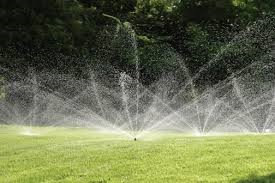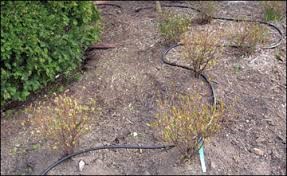As the days are getting warmer and the rain is tapering off, we need to start thinking of regularly watering our landscape. Even though many plants are able to survive our dry summers, all plants will benefit from a regular watering schedule. Having an irrigation system makes all the difference in being able to apply the amount of water needed at the time it is needed.
There are many options when it comes to irrigation systems depending on how we want to irrigate. When it comes to irrigating, we have come a long way from the mindset of just letting the water fly. Even in places like the Pacific Northwest where there is an abundance of rain, clean water is still a precious commodity that needs to be managed and not wasted. We want to make sure we are being water-wise when it comes to irrigating our landscapes.
Some of these newer technologies that are being developed make more efficient use of water, while efficiently supplying plants what they need. Many drip products and MP Rotator nozzles are some new technologies that have transformed how we irrigate.
MP Rotators are a nozzle that delivers multiple streams of water at a steady rate. This slower application allows water to gently soak into the soil achieving an even distribution throughout the area being irrigated. This increased efficiency results in 30% less water use when compared to traditional spray nozzles. These streams of water deliver larger water droplets which minimizes loss to evaporation. The slower precipitation rate allows water to soak into the soil avoiding excessive runoff. This slower rate mimics a steady rain fall in a natural system. When installed and spaced as designed, there is no other product that can provide higher efficiency when providing even distribution over a given area.


While MP Rotators work well for even water distribution, drip irrigation is the most efficient way to irrigate bed areas. The use of drip irrigation works well to apply water directly to the root zone of the plants. By directing the water, open areas between plants are not unnecessarily being irrigated. Drip irrigation is the most efficient type of system; however, it only works if you do not need even distribution throughout the area.



Using these efficient products provides precision to how we apply water, but if allowed to run excessively, we are still wasting water. In conjunction with using efficient products, we need to program the system to irrigate as minimally as possible. When irrigating, avoid watering every day. Water enough to saturate the root zone then allow a dry out period before irrigating again. This could take from a couple of days to a couple of weeks depending on soil type and exposure. For most soils, watering 2-3 times a week is adequate as long as enough water is applied at each irrigation. This watering pattern will force the roots to grow deeper into the soil. Watering every day will keep the roots at the surface, making them vulnerable to heat waves and sudden lapses in irrigation.
With the use of timers and systems that employ these new products, irrigating our landscapes can done effectively and efficiently. When we irrigate appropriately, we can establish a strong landscape that can survive and thrive with minimal water.

